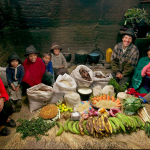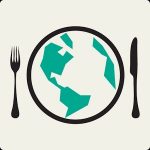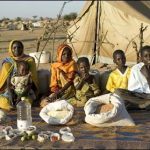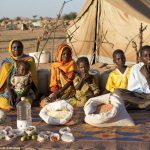Two Americas, One World Food System

The photos of what an American family and what an Ecuadorian family eat depicted in the photographic project Hungry Planet show sharp contrasts in the lifestyles and the food systems of those countries. Firstly, the Ecuadorian family lives in a traditional, rural village in the mountains in a thatch-roofed adobe-brick-walled...Read More »
Hunger as a Failure of Human Decency
Peter Menziel’s Hungry Planet Gallery synthesizes culture surrounding food and family life in a way that words themselves typically would fail to do. For one thing, the US gallery should be a lesson in excess. One can easily see the massive influence of corporate America by simply following along with...Read More »
Insights on a Hungry Planet

(source: http://lh4.ggpht.com/)
Our world is filled with various cultures and each culture has cuisine that is a representative of their norms, behaviors, and other feat that would mark how one might consume food. In my paper, I compared the food of a US family and that of a...Read More »
Processed Food for a Hungry Planet

In Hungry Planet: What the World Eats, Peter Menzel captures the effects of our changing world in ways that words cannot. Significant cultural and economic patterns emerge throughout the collection of photographs. Industrialization, globalization, and international trade continue to influence culture, food practices, health, and consumption behavior at the local...Read More »
Hungry Planet - Australia and Chad

After comparing families from Chad and Australia I found that the people in the developing country of Chad are “starving because the policy structures that defended rural livelihoods, and access to resources and markets, and hence entitlements and incomes, are being systematically dismantled by structural adjustment programmes, driven by the...Read More »
Hungry Planet

The modern world is divided economically into the global north and global south, or simply put, developed and developing nations. Due to the economic inequalities between developed and developing countries, there are vast disparities in the daily lives of the citizens of France for example, and those who call Chad...Read More »
Hungry Planet - Chad and France

While looking through the Hungry Planet gallery for my two chosen countries, Chad and France, the differences were striking. It’s hard to overstate how different the two countries seem just from a gallery of a few pictures. The families in Chad had a sad, dreary, pain-ridden tone that was evident for...Read More »
Hungry Planet; the US and Ecuador

Comparing photos from Peter Menzel’s Hungry Planet, of both affluent and developing countries, I was instantly disturbed by the obvious differences between the United States and Ecuador. Both countries clearly differ when it comes to sustainability, wealth, and resources. In Ecuador we see food laid out on the floor of...Read More »
Hungry Planet
In Peter Menzel’s photographic essay, “Hungry Planet”, the greatest difference in dietary habits was seen between the United States of America, and Chad. These countries differ drastically in their wealth, development, and resources, which is seen through this photographic essay. In the photos from the families living in the United...Read More »
Hungry Planet: From Chad to Australia
The Hungry Planet paper helped me to look closer at different countries and how they eat. It helped to show me how much different eating habits are across cultures, while also showing how similar others are. Families in Australia eat similar foods to the United States, where countries who do...Read More »
Comparing Nations

Taking a look at Peter Menzel’s online Hungry Planet gallery , a photographic essay on the dietary habits of families all around the world…
Making a side-by-side comparison of the food cultures of the two contrasting countries, Germany (an affluent one) & Chad (a developing...Read More »
Bounties

Arrayed on the table before the Guatemalan Mendoza family was a colorful bounty of fresh food for the week – tomatoes, squash, carrots, green beans, garlic, potatoes, and among other things, two large burlap sacks full of grain.
In sharp contrast, the Caven family from California...Read More »
Hungry Planet Paper: Japan and Ecuador

https://www.tes.com/lessons/hetCPtgBCuMx8g/japan-cultures
Peter Menzel’s Hungry Planet depicts the various dietary and health lifestyles choices from various families around the globe. The Western diet, generally consisting of red meats, refined grains, processed foods, high fat and sugar content, as well as large food chains such...Read More »
Blog 4 English and Guatemalan Diets
Blog post 4 on hungry planet paper
For my paper, I chose images 16 and 18 with a Guatemalan family and an English family. The main difference between the two was that the English family had a diet high in processed food, but had variety, almost nothing was purchased in bulk....Read More »
